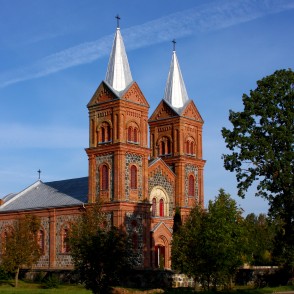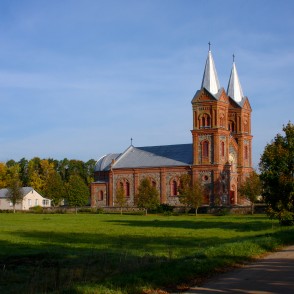Archeological excavations give evidence that Stirniene and its vicinity has been inhabited since the late Iron Age - the 9th century AD.
In the 1483 chronicle it is mentioned that Stirnen belongs to counts Borchs.
In other chronicle you can read that before the 1710 – 11 plague epidemic “ a cat could go from Stirniene to Varaklani along the house fences”.
It is believed that in the 18th century Stirniene became an independent congregation. The oldest inscriptions in the congregation’s metrics books come from 1796. The first churches were wooden buildings which were destroyed by fires.
In 1757–67 a wooden church was built which was later taken to Rudzati village (in 1913) because a new stone church was built (1902 – 1908) in Stirniene and on July 29 1914 it was consecrated by V. Kluczynski, archbishop of Mogilev.
The construction was run by dean Pavils Virketis who was buried in the church-yard. Stirniene church is a 25.5 m long and 15.3 m wide stone and brick building with a tin-plate roof and two 36m high towers. Inside there are 3 vaults with an arched ceiling which bases on stone pillars. There are three altars, two sacristies and a room for choir singers.
During the World War II the church was heavily damaged, the roof, one of the towers and the organ were destroyed by bombing. After the war the church was reconstructed thanks to deans’ activities and a big support of congregation members. In 1985 the interior was whitewashed, the panel was painted with oil-paint and the altars were gilded. In 2006 the congregation received a gift from Goettingen congregation in Germany – an organ. In summer 2007 it was installed by the specialists of Alvis Melbardis organ-workshop. After a 65 years break Stirniene church organ sounds again to praise God and delight people.
www.stirnienesbaznica.lv



